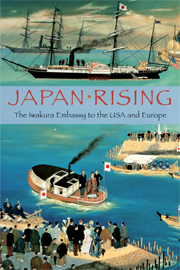Book contents
- Frontmatter
- Contents
- Introduction by Ian Nish
- Note on the Text
- VOLUME I THE UNITED STATES OF AMERICA
- Preface
- 1 The Voyage across the Pacific
- 2 A Survey of the United States of America
- 3 A Record of San Francisco, 1
- 4 A Record of San Francisco, 2
- 5 The Railroad Journey in the State of California
- 6 The Railroad Journey in the State of Nevada and Utah Territory
- 7 The Rocky Mountain Railroad
- 8 The Chicago Railroad
- 9 The Railroad Journey from Chicago to Washington, D.C.
- 10 A Survey of the District of Columbia
- 11 A Record of Washington, D.C., 1
- 12 A Record of Washington, D.C., 2
- 13 A Record of Washington, D.C., 3
- 14 The Journey Through the Northern States, 1
- 15 The Journey Through the Northern States, 2
- 16 The Journey Through the Northern States, 3
- 17 A Record of Washington, D.C.: Epilogue
- 18 A Record of Philadelphia
- 19 A Record of New York City
- 20 A Record of Boston
- VOLUME II BRITAIN
- VOLUME III CONTINENTAL EUROPE, 1
- VOLUME IV CONTINENTAL EUROPE, 2
- VOLUME V CONTINENTAL EUROPE, 3; AND THE VOYAGE HOME
- Index
8 - The Chicago Railroad
Published online by Cambridge University Press: 04 August 2010
- Frontmatter
- Contents
- Introduction by Ian Nish
- Note on the Text
- VOLUME I THE UNITED STATES OF AMERICA
- Preface
- 1 The Voyage across the Pacific
- 2 A Survey of the United States of America
- 3 A Record of San Francisco, 1
- 4 A Record of San Francisco, 2
- 5 The Railroad Journey in the State of California
- 6 The Railroad Journey in the State of Nevada and Utah Territory
- 7 The Rocky Mountain Railroad
- 8 The Chicago Railroad
- 9 The Railroad Journey from Chicago to Washington, D.C.
- 10 A Survey of the District of Columbia
- 11 A Record of Washington, D.C., 1
- 12 A Record of Washington, D.C., 2
- 13 A Record of Washington, D.C., 3
- 14 The Journey Through the Northern States, 1
- 15 The Journey Through the Northern States, 2
- 16 The Journey Through the Northern States, 3
- 17 A Record of Washington, D.C.: Epilogue
- 18 A Record of Philadelphia
- 19 A Record of New York City
- 20 A Record of Boston
- VOLUME II BRITAIN
- VOLUME III CONTINENTAL EUROPE, 1
- VOLUME IV CONTINENTAL EUROPE, 2
- VOLUME V CONTINENTAL EUROPE, 3; AND THE VOYAGE HOME
- Index
Summary
February 25th, 1872.
Our train stopped on the west bank of the Missouri River and we waited several hours while our luggage was transferred into cars belonging to the Chicago Railroad. Then the train began to proceed slowly over the still unfinished bridge to the other side of the river.
The rich, moist loam of the Mississippi and Missouri basin is very suitable for growing Indian corn, the common grain grown in the most fertile regions of these states. Corn is said to have first been the staple crop of the native Indians of this area, hence the name ‘Indian corn’, and the practice then spread around the world. Corn is very nourishing, but the kernels are hard and difficult to digest and, according to physicians who have conducted experiments, can take as many as five hours to digest. However, if eaten with other, more digestible grains and meat, it is good for the stomach. Enormous quantities of corn are exported to Britain, especially from the states of the Mississippi River basin.
February 26th. Fine.
At three o'clock in the morning we passed Burlington, where we crossed a long bridge over the Mississippi. The river marks the boundary between the states of Iowa and Illinois, and we were now entering Illinois.
- Type
- Chapter
- Information
- Japan RisingThe Iwakura Embassy to the USA and Europe, pp. 47 - 51Publisher: Cambridge University PressPrint publication year: 2009



